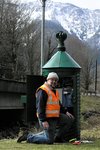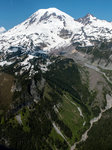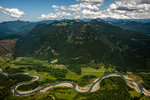


Before my retirement a couple of years ago, I worked on a stream gage network that provides data used for managing water resources and promoting salmon recovery. While doing this streamflow monitoring work for Washington's Department of Ecology, I noticed something odd in the Stillaguamish River Basin.
During the long dry summer of 2005, I operated two gages on similar streams feeding the North Fork Stillaguamish River. The streams drain adjacent basins in the North Cascades. Both streams flow down steep valleys from separate areas above 6500 feet on a peak called the Three Fingers.
By late September, the stream that drains the east slope of Three Fingers, Squire Creek, had basically run dry, carrying just a trickle of very warm water. The other stream, Boulder River, drains the west slope of the Three Fingers and kept a flow of 15 to 20 cubic feet per second of cool water in spite of the long hot spells.
So what was it about these two streams that would explain the difference in late summer flow?
A little basic map work showed the answer.
At the headwaters of Boulder River is the small Queest-Alb glacier. Squire Creek, on the other hand, had no permanent ice feature at its headwaters. The water that kept Boulder River flowing was meltwater from the Queest-Alb. Similar conditions occurred on these two streams in the fall of 2006 and again in the very dry summer of 2015.
Nearby along the Canadian border, the glaciated slopes of Mount Baker drain into the Nooksack River along with various lowland streams. The glaciers on Mount Baker have been studied intensely for more than 30 years. These studies show in great detail how glacier-fed streams maintain a steady flow of cold water through long hot spells, while streams not fed by ice features drop to much lower levels and become much warmer in hot weather.
The differences I noticed in late summer flow on Boulder River and Squire Creek offer a preview of what Washington can expect as climate change continues to eat away at mountain glaciers and alter the nature of the streams they feed.
Here in Southwest Washington, rivers including the Cowlitz, the Cispus, the Lewis, the White Salmon and the Klickitat all face major changes as mountain glaciers recede and start to disappear.
During the 20th century, the area covered by glacial ice on Mount Rainier decreased by about 24 percent. On Mount Hood, the decrease was 32 percent. On Mount Adams, which feeds some of Southwest Washington’s best salmon and steelhead streams, the loss of ice-covered area during the 20th century was 49 percent. In all of these areas, the rate of ice loss is accelerating along with the rate of increase in atmospheric carbon dioxide.
The drought of 2015 was a great example of what climate models predict for the Northwest.
By February that year, winter snowpack was gone. Spring and summer were the hottest on record. Salmon and summer steelhead were suffocating in record warm, low streams. Were it not for an early return of fall rains, fish losses would have been even worse.
While no one is certain just how fast glaciers will recede in coming years, the current climatic trends are clear. The forcing mechanisms are well understood. Atmospheric carbon levels have moved well beyond the historic range of variability. The level of atmospheric carbon dioxide has risen from 315 parts per million (ppm) in the late 1950s to 405 ppm in 2017. Ice cores from Antarctica show that CO2 levels did not exceed 300 ppm in the 800,000 years preceding the industrial age. The warming effect of that increase in CO2 is a matter of simple physics. It's as undeniable as the force of gravity.
What kind of salmon and steelhead habitat do we want to leave as our legacy in Washington? Do we choose to reduce carbon emissions or do we leave our children and grandchildren to deal with the consequences?
Citizens' Climate Lobby is working hard to build bipartisan support in Congress for a revenue-neutral carbon fee and dividend. This policy would move our economy away from carbon-based energy while returning a financial dividend to everyday citizens. Right now, Citizens' Climate Lobby has 33 Republican and 33 Democratic members of Congress in its Climate Solutions Caucus seeking solutions to the climate crisis. Local volunteer chapters in Vancouver, Centralia/Chehalis and Long Beach are asking U.S. Rep. Jaime Herrera-Beutler, R-Battle Ground, to get on board.
I urge readers to take climate change seriously. Learn more about the Citizens' Climate Lobby. Please visit "citizensclimatelobby.org"
•••
Don Watt, a Chehalis resident, is a 1972 graduate of Oregon State University where he studied earth sciences and meteorology. He has worked for the National Weather Service and the Washington Department of Ecology. He retired in 2016. Watts also spent a few years working at the Lewis County 911 Center in the 1980s.